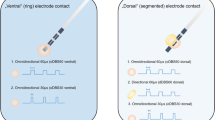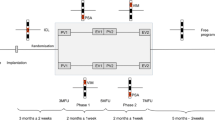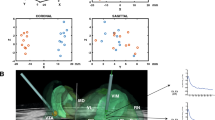Abstract
In patients with essential tremor (ET) already treated with chronic deep brain stimulation (DBS) of the nucleus ventralis intermedius (VIM) we investigated whether optimization of stimulation parameters could improve clinical tremor suppression, and whether this putative effect could be sustained over time. Twenty-three ET patients with VIM-DBS participated in the prospective study. All electrode contacts were tested systematically and stimulation parameters were optimized over the course of 2 days. Clinical tremor rating scale (TRS) was videotaped before, directly after the optimization and at a 10 weeks follow-up and evaluated blindly and independently by two clinicians. For stimulation effect optimization we increased the number of active contacts whereas the total charge applied to the tissue was kept constant. TRS hemi-body scores decreased significantly after optimization. At the 10 weeks follow-up, however, the improvement had faded and was no longer significant. The activities of daily living (ADL) remained significantly improved. Systematic optimization of VIM-DBS parameters in ET patients leads to a short term improvement which habituates over time. Our results provide further evidence for a tolerance effect in chronic VIM stimulation thereby suggesting that frequently alternating stimulation protocols should be tested in future studies of ET patients treated with VIM-DBS.
Similar content being viewed by others
Avoid common mistakes on your manuscript.
Introduction
Chronic high frequency deep brain stimulation (DBS) of the thalamic nucleus ventralis intermedius (VIM) is effective for long term treatment of parkinsonian and essential tremor (ET) [1–3]. However, loss of tremor suppression due to tolerance to chronic stimulation has been reported by several studies [1, 4, 5]. Three possible explanations for this tolerance effect have been discussed. Firstly, disease progression could lead to an increase of tremor and subsequently necessitate increased currents to reach satisfactory tremor suppression. This argument seems to hold true for the long term studies with at least 2 years of follow-up [1, 5]. Secondly, early tolerance could be due to a declining effect of microthalamotomy directly after surgery. However, this argument cannot solely explain tolerance in general since a late tolerance was reported even between 6 and 12 months after implantation [4]. In this later period a pronounced microthalamotomy effect has long subsided and can therefore be excluded as a possible confound. Thirdly, according to Benabid and co-workers, tolerance could be due to an adaptation of the biological response of the stimulated neuronal network. The latter is suggested by observation that stimulation after “DBS holidays” has been reported to improve the tremor suppressing effect and reduce DBS-induced side-effects compared to previous chronic stimulation [6, 7].
In the present study we investigated whether (a) optimization of stimulation parameters in patients with ET treated with chronic VIM-DBS leads to an improvement in tremor suppression and (b) whether this effect is sustained over 10 weeks. DBS parameters were systematically optimized and Tremor Rating Scales (TRS) including items for activities of daily living (ADLs) were assessed before, directly after and 10 weeks past optimization. We hypothesized that stimulation optimization may lead to an intermediate improvement which fades again over time.
Methods
Patients
We systematically contacted all ET patients who had been implanted with a DBS system in the VIM in our centre between 1995 and 2009. Thalamotomy prior to DBS implantation was an exclusion criterion. Only patients that had been operated at least 3 months before hospitalization where included into the study to exclude the possibility of an ongoing microthalamotomy effect. Thus, a total of 23 subjects met all inclusion criteria and participated in this study. The exact localization of the electrodes was confirmed via stereotactic X-ray or CCT for each single patient and projection of the image on the preoperative MRI. The stereotactic coordinate of the most ventral active contact was taken for analysis in case two contacts were activated. The mean ± SD stereotactic coordinates from 28 electrodes (from the 16 patients who were seen at the 10 week follow-up) are shown in Table 1.
Study design
Patients were admitted to the Department of Neurology of the University Hospital Cologne for optimization of the DBS-parameters. Before any change of the DBS parameters was made, patients were videotaped while performing the Clinical Tremor Rating Scale (TRS) [8] including the assessments of the ADLs. Afterwards, all four contacts on each electrode were systematically tested from 0 to 5 V in 1 V-increments. The effect on different types of tremor and possible side effects was documented and the best contact (i.e. best effect without or with still tolerable side effects) was determined. In case of side effects the activation of an additional more dorsal contact with reduction of the charge per contact was tested. After identification of the best contact and amplitude, the stimulation settings were changed and further optimization was performed during the following 2 days. Patients were seen at least three times daily for stimulation parameter programming. All patients were asked before discharge, whether the new DBS settings were better than those applied prior. In case patients reported no improvement either for tremor suppression or reduction of side effects after 2 days, the stimulation was reset to the initial parameters. At least 12 h after the last change of parameters, another TRS was videotaped the morning before discharge. Approximately 10 weeks after hospitalisation, patients were seen on an outpatient follow-up visit and a third TRS was videotaped.
Analysis
TRS items 1, 2, 4, 7, 9, 11, 12a, 12b, 12c, and 13 for motor function and 14–21 for Activities of Daily Living (ADL) function were collected and analysed independently by two clinicians (M.T.B and K.A.M.P) blinded for time and stimulation parameters. TRS interrater reliability revealed an average free marginal kappa of 0.71 ± 0.17 (mean ± SD). Each electrode and the corresponding contralateral TRS hemi-body score were analysed. For the sake of comparison between the total charge applied to the tissue at different timepoints of evaluation, amplitude, pulse rate, and pulse duration were transformed to the ‘corrected amplitude’ introduced by Rehncrona and co-workers [9].
Statistics
Statistical analysis was performed using PASW Statistics 18. Student paired t-tests were performed to detect significant differences between different timepoints of TRS evaluation. For multiple testing, level of significance was α-corrected by division of the p-value by the amount of comparisons. Post-hoc nonparametric analysis (Wilcoxon test) was performed when data did not match the assumptions for normality tested with the Kolmogorov–Smirnov test. A value of p ≤ 0.05 was defined as the level of significance. Results in the text and figure legends are presented as mean ± 1 SD. Interrater reliability was conducted with the help of an online kappa calculator [10].
Ethics
This study was approved by the Local Ethics Committee of the University of Cologne (study number 08-269). Each patient gave written informed consent before study participation. Research was conducted in accordance with the Declaration of Helsinki.
Results
Immediate effect
Twenty three patients agreed to participate in the study and were admitted to hospital for systematic testing and optimization of the stimulation parameters for 3 days. Patient characteristics are presented in Table 2. Out of the 23 patients that participated in the study, 21 (91%) agreed on maintaining the optimized settings. The two patients that had no benefit from optimization (patient number 22 and 23) were excluded from further analysis since the old parameter settings were re-set. They showed a similar TRS at the day of admission compared to the day of discharge (11.5–12.5 and 10.5–8.5, respectively). Thus, 21 patients/35 electrodes (3 patients were implanted unilaterally and in 4 patients only the right TRS hemi-body-score was videotaped initially) could be analysed for the immediate optimization effect. For optimization we increased the number of active electrode contacts (52 activated contacts before, 67 activated contacts after optimization). Total corrected amplitude did not change significantly before and after optimization (4.10 ± 2.98 and 4.38 ± 3.25). As a consequence, corrected amplitude per contact decreased significantly from 2.95 ± 1.41 to 2.5 ± 1.26 as shown in Fig. 1a. Blinded analysis of TRS hemi-body scores revealed a significant improvement from 10.93 (±7.53) to 7.39 (±5.17) which is illustrated in Fig. 1b. Interestingly, after optimization, in 26 out of 35 (74%) electrodes the second most ventral contact was activated most often, followed by the second most dorsal 17 out of 35 (49%), then the most ventral 15 out of 35 (43%), and finally the most dorsal 1 out of 35 (3%).
Stimulation parameter optimization with immediate improvement and long-term habituation on tremor severity. a For optimization we increased the total number activated contacts (filled squares) significantly (**p ≤ 0.01) whereas the total corrected amplitude per contact in [V] (filled circles) was significantly reduced (***p ≤ 0.001). Total corrected amplitude between different timepoints did not change significantly (data not shown). Data from 21 patients (35 hemispheres) was analysed. b Immediate effect of optimization. TRS hemi-body scores were significantly reduced (***p ≤ 0.001). Data from 21 patients (35 hemispheres) was analysed. c At 10 week follow up, 16 patients (28 hemispheres) were evaluated. TRS hemi-body scores showed an improvement for the immediate effect after optimization (***p ≤ 0.001). After 10 weeks, however, TRS revealed no significant improvement compared to baseline (n.s.). Also, the effect after direct optimization compared to follow-up after 10 weeks differed significantly (**p ≤ 0.01). d Activities of Daily Living (ADL) items of the TRS improved significantly at the 10 week follow-up compared to baseline evaluation (**p ≤ 0.01)
Long-term effect
Sixteen of the 21 patients/28 electrodes (1 patient was implanted unilaterally, 3 patients were videotaped only right TRS hemi-body score before) where parameter optimization had led to an effect agreed to participate in a follow up visit approximately 10 weeks (9.38 ± 2.03) after the optimization phase. Reasons for not participating in the follow-up were (a) long travel distances (2 patients), (b) severe tremor increase, so that the neurologist had been consulted between discharge and follow-up (2 patients), and (c) death due to cardiac arrest (1 patient). Analysis revealed a significant weaker stimulation effect at 10 week follow-up compared to the immediate effect (Fig. 1c) thereby abolishing the immediate significant improvement 10 weeks after optimization. There were, however, some patients with a remarkable improvement at the 10 week follow-up (see Fig. 2). For further analysis we divided all TRS scores at the 10 week follow up into 3 groups. At follow up, 15 TRS scores increased or remained equal compared to TRS before optimization, 8 TRS scores decreased compared to TRS before optimization but increased compared to TRS after optimization, and 5 TRS scores remained equal or decreased further compared to TRS after optimization. In sum, the parameter changes on 13 electrodes showed at least some 10 week lasting benefit, whereas the new parameter settings on 15 electrodes did not. Analysis of the ADL-items of the TRS, however, showed significant improvement at the 10 week follow up compared to baseline (see Fig. 1d).There was no difference in habituation between action tremor and postural tremor (data not shown).
TRS hemi-body scores before optimization, after optimization and at the 10 week follow-up. The hemibody-TRS before optimization, after optimization and at the 10 week follow-up are shown for 28 electrodes from 16 patients. Note that some TRS scores show a relevant improvement even at the 10 week follow up compared to the TRS before optimization
Discussion
Multiple studies have shown in ET patients a tolerance effect to DBS in the VIM. However, microthalamotomy and/or disease progression as confounding factors could never be definitely excluded. Therefore, our study was designed to avoid both factors. Firstly, we evaluated ET patients over a relatively short time window of 10 weeks to exclude relevant disease progression. Secondly, only patients at least 3 months post implantation were investigated to exclude any pronounced microthalamotomy effect. Thirdly, TRS hemi-body scores were evaluated by two blinded raters. As a limitation, our study had a considerable drop out (5 of 21 patients) at the 10 week follow up. However, the reasons for drop out are not indicating a systematic bias.
Our data might indicate that acute changes of the stimulation parameters lead to an immediate disturbance of the pathological ET tremor network [11] thus resulting in tremor suppression. Over the time of 10 weeks, the pathological tremor network seems to adapt to this interference resulting clinically in habituation and subsequent tremor increase. Thus, frequently alternating parameter settings might result in a more enduring effect of chronic DBS over time. We therefore hypothesize that ET patients frequently switching between two equivalent but slightly different stimulation settings (i.e. group A and B) might benefit more from DBS compared to patients with constant stimulation. Also, instead of further increasing stimulation amplitude until side effects occur alternating stimulation could possibly save the total charge applied to the tissue and thereby reduce possible stimulation-induced side effects and also extend battery life. A similar approach was described for DBS “holidays” [6, 7]. However, the tremor rebound and loss of quality of life during these holidays renders this option suitable for a small number of patients only. Further studies are required to test whether alternating stimulation settings improve durability of chronic DBS compared to constant stimulation. With the new generation of IPGs the patients can themselves perform these switches between different programs predefined by the treating physician.
In patients with Parkinson’s disease treated with DBS in the subthalamic nucleus a positive clinical effect of a systematic re-evaluation of DBS-parameters has been shown [12].
Our study shows that in ET patients despite habituation, it is useful to re-assess stimulation parameters even a long time after implantation, since a considerable number of patients still show a benefit after 10 weeks. In line with this, ADL scores significantly improved at 10 weeks follow-up compared to baseline evaluation. One might speculate, that the significant improvement in the ADLs despite the rating in the TRS motor ratio is (a) due to reduction of side effects like dysarthria thus leading to better social functioning as well as (b) improvements in critical ADL tasks (e.g. eating soup with a spoon) that are more sensitive to tremor improvement than the motor items of the TRS.
References
Benabid AL, Pollak P, Gao D, Hoffmann D, Limousin P, Gay E, Payen I, Benazzouz A (1996) Chronic electrical stimulation of the ventralis intermedius nucleus of the thalamus as a treatment of movement disorders. J Neurosurg 84(2):203–214. doi:10.3171/jns.1996.84.2.0203
Limousin P, Speelman JD, Gielen F, Janssens M (1999) Multicentre european study of thalamic stimulation in parkinsonian and essential tremor. J Neurol Neurosurg Psychiatry 66(3):289–296
Schuurman PR, Bosch DA, Bossuyt PM, Bonsel GJ, van Someren EJ, de Bie RM, Merkus MP, Speelman JD (2000) A comparison of continuous thalamic stimulation and thalamotomy for suppression of severe tremor. N Engl J Med 342(7):461–468
Hariz MI, Shamsgovara P, Johansson F, Hariz G, Fodstad H (1999) Tolerance and tremor rebound following long-term chronic thalamic stimulation for parkinsonian and essential tremor. Stereotact Funct Neurosurg 72(2–4):208–218. doi:10.1159/000029728
Koller WC, Lyons KE, Wilkinson SB, Troster AI, Pahwa R (2001) Long-term safety and efficacy of unilateral deep brain stimulation of the thalamus in essential tremor. Mov Disord 16(3):464–468
Garcia Ruiz P, de Igneson MJ, Lopez Ferro O, Martin C, Magarinos Ascone C (2001) Deep brain stimulation holidays in essential tremor. J Neurol 248(8):725–726
Kronenbuerger M, Fromm C, Block F, Coenen VA, Rohde I, Rohde V, Noth J (2006) On-demand deep brain stimulation for essential tremor: a report on four cases. Mov Disord 21(3):401–405. doi:10.1002/mds.20714
Fahn (1988) Clinical rating scale for tremor. In: Tolosa JJaE (ed) Parkinson’s disease and movement disorders. Urban & Schwarzenberg, Baltimore, pp 225–234
Rehncrona S, Johnels B, Widner H, Tornqvist AL, Hariz M, Sydow O (2003) Long-term efficacy of thalamic deep brain stimulation for tremor: double-blind assessments. Mov Disord 18(2):163–170. doi:10.1002/mds.10309
Randolph JJ (2008) Online kappa calculator. Retrieved March 30, 2010, from www.justus.randolph.name/kappa
Schnitzler A, Munks C, Butz M, Timmermann L, Gross J (2009) Synchronized brain network associated with essential tremor as revealed by magnetoencephalography. Mov Disord 24(11):1629–1635. doi:10.1002/mds.22633
Moro E, Poon YY, Lozano AM, Saint-Cyr JA, Lang AE (2006) Subthalamic nucleus stimulation: improvements in outcome with reprogramming. Arch Neurol 63(9):1266–1272. doi:10.1001/archneur.63.9.noc60069
Acknowledgments
We thank the patients for study participation and cooperation. This study was supported by a grant of the German Research Foundation (DFG), Clinical Research Group 219 (KFO 219) to L.T. and G.R.F (TI 319/2-1, FI 773/8-1 and SCHU 1439/3-1).
Conflict of interest
None.
Author information
Authors and Affiliations
Corresponding authors
Rights and permissions
About this article
Cite this article
Barbe, M.T., Liebhart, L., Runge, M. et al. Deep brain stimulation in the nucleus ventralis intermedius in patients with essential tremor: habituation of tremor suppression. J Neurol 258, 434–439 (2011). https://doi.org/10.1007/s00415-010-5773-3
Received:
Revised:
Accepted:
Published:
Issue Date:
DOI: https://doi.org/10.1007/s00415-010-5773-3






